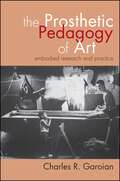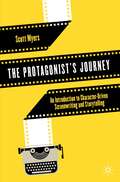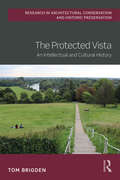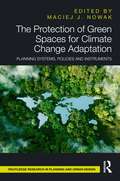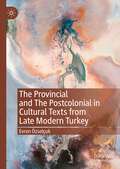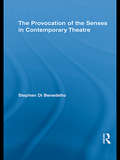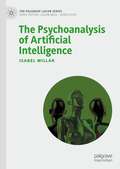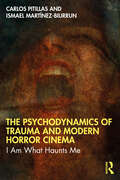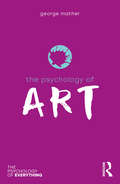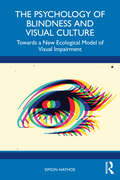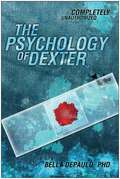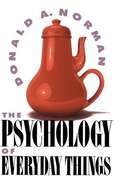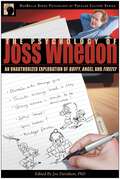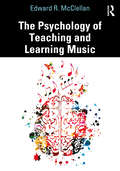- Table View
- List View
The Prosthetic Pedagogy of Art: Embodied Research and Practice
by Charles R. GaroianBy beginning each chapter of The Prosthetic Pedagogy of Art with an autobiographical assemblage of personal memory and cultural history, Charles R. Garoian creates a differential, prosthetic space. Within these spaces are the particularities of his own lived experiences as an artist and educator, as well as those of the artists, educators, critics, historians, and theorists whose research and creative scholarship he invokes—coexisting and coextending in manifold ways. Garoian suggests that a contiguous positioning of differential narratives within the space of art research and practice constitutes prosthetic pedagogy, enabling learners to explore, experiment, and improvise multiple correspondences between and among their own lived experiences and understandings, and those of others. Such robust relationality of cultural differences and peculiarities brings about interminable newness to learners' understanding of the other, which challenges the intellectual closure, reductionism, and immutability of academic, institutional, and corporate power.
The Protagonist's Journey: An Introduction to Character-Driven Screenwriting and Storytelling
by Scott MyersCharacter drives plot. Based on this principle, this book walks aspiring writers through the fascinating world of character-driven screenwriting. When a writer engages their characters, they start a process which naturally leads to the story’s structure and everything else that makes for a well-written narrative. Exploring the protagonist’s journey and their “unity arc,” Myers explains how a family of characters surrounds the protagonist and influences their transformation process. This easy-to-follow guide features activities that will help writers of any level develop their stories from concept to scene-by-scene outline. Based upon a popular workshop Myers has led with over a thousand writers at all levels of experience, this book is a must-have for screenwriting students, both undergraduate and graduate, and those looking at advanced story development.
The Protected Vista: An Intellectual and Cultural History (Routledge Research in Architectural Conservation and Historic Preservation)
by Tom BrigdenThe Protected Vista draws a historical lineage from the eighteenth-century picturesque to present-day planning policy, highlighting how the values embedded within familiar views have developed over time through appropriation by diverse groups for cultural and political purposes. The book examines the intellectual construction of the protected vista, questioning the values entrenched within the view, by whom, and how they are observed and disseminated, to reveal how these views have been, and continue to be, part of a changing historical and political narrative. With a deeper knowledge and understanding of the shifting values in urban views, we will be better equipped to make decisions surrounding their protection in our urban centres. The book identifies the origins of current view protection policy in the aesthetic convention of the picturesque, drawing on a range of illustrated examples in the UK, the US, Australia, Canada and South Africa, to serve as a useful reference for students, researchers and academics in architecture, architectural conservation, landscape and urban planning.
The Protection of Green Spaces for Climate Change Adaptation: Planning Systems, Policies and Instruments (Routledge Research in Planning and Urban Design)
by Maciej J. NowakThe Protection of Green Spaces for Climate Change Adaptation identifies how spatial planning and climate change adaptation are linked by examining the protection of green spaces in cities across Europe, Africa, the Middle East, South America and Australia.This book identifies how, in each case, spatial planning instruments can influence the protection of green spaces, and whether – and if so how – they are being adapted in response to actual and expected effects from climate change. In doing so, the institutional frameworks of each country analysed are first presented. This provides the basis for discussing the key problems occurring at the state (and city) level in responding to the challenges of climate change adaptation, especially for the protection of green spaces. In the individual chapters, the issues identified above will be analysed from the perspective of diverse countries: Australia, Ghana, Iran, Mexico, Brazil and Poland. The contributors in this edited collection will present how the indicated issue is identified in systems that are diverse in many respects. This book concludes by demonstrating how the relationship between climate change adaptation and spatial planning can be framed in a more universal way, taking into account the international case studies that have been presented. This book deals extensively with both climate change adaptation issues and comparisons of spatial planning systems.By focusing on a synthesis of these issues, this book will add significantly to the discussion, providing a new basis for theoretical and practical considerations. It will be of interest to researchers and students of spatial planning, public policy, environmental protection, climate protection and law, as well as professionals working in these areas.
The Provincial and The Postcolonial in Cultural Texts from Late Modern Turkey
by Evren ÖzselçukThis book explores Turkey’s complicated relationship to modernity and its status within the new global order by tracing the ambivalent ways in which taşra (the provinces) is constituted in contemporary Turkish cinema and literature. Connoting much more than its immediate spatial meaning as those places outside of the center(s), taşra is a way of naming what modernity decries as spatial peripherality, temporal belatedness, and cultural backwardness. It has functioned historically as a psychosocial repository for what Turkish modernity degrades and disavows, enabling a mapping of the predicaments and contradictions of Turkish modernization and national identity-constitution. Organized around taşra as its central analytic and informed by postcolonial, psychoanalytical, and critical theory, the book examines the extent to which dominant codings of taşra are affirmed and/or complicated in cinematic and literary narratives by award-winning filmmakers Nuri Bilge Ceylan and Fatih Akın and Nobel laureate Orhan Pamuk.
The Provocation of the Senses in Contemporary Theatre (Routledge Advances In Theatre And Performance Studies #13)
by Stephen Di BenedettoDi Benedetto considers theatrical practice through the lens of contemporary neuroscientific discoveries in this provoking study, which lays the foundation for considering the physiological basis of the power of theatre practice to affect human behavior. He presents a basic summary of the ways that the senses function in relation to cognitive science and physiology, offering an overview of dominant trends of discussion on the realm of the senses in performance. Also presented are examples of how those ideas are illustrated in recent theatrical presentations, and how the different senses form the structure of a theatrical event. Di Benedetto concludes by suggesting the possible implications these neuroscientific ideas have upon our understanding of theatrical composition, audience response, and the generation of meaning.
The Psycho Records
by Laurence Rickels?The Psycho Records follows the influence of the primal shower scene within subsequent slasher and splatter films. American soldiers returning from World War II were called "psychos" if they exhibited mental illness. Robert Bloch and Alfred Hitchcock turned the term into a catch-all phrase for a range of psychotic and psychopathic symptoms or dispositions. They transferred a war disorder to the American heartland. Drawing on his experience with German film, Hitchcock packed inside his shower stall the essence of schauer, the German cognate meaning "horror." Later serial horror film production has post-traumatically flashed back to Hitchcock's shower scene. In the end, though, this book argues the effect is therapeutically finite. This extensive case study summons the genealogical readings of philosopher and psychoanalyst Laurence Rickels. The book opens not with another reading of Hitchcock's 1960 film but with an evaluation of various updates to vampirism over the years. It concludes with a close look at the rise of demonic and infernal tendencies in horror movies since the 1990s and the problem of the psycho as our most uncanny double in close quarters.
The Psychoanalysis of Artificial Intelligence (The Palgrave Lacan Series)
by Isabel MillarThis book examines the crucial role of psychoanalysis in understanding what AI means for us as speaking, sexed subjects. Drawing on Lacanian theory and recent clinical developments it explores what philosophy and critical theory of AI has hitherto neglected: enjoyment. Through the reconceptualization of Intelligence, the Artificial Object and the Sexual Abyss the book outlines the Sexbot as a figure who exists on the boundary of psychoanalysis and AI. Through this figure and the medium of film, the author subverts Kant’s three Enlightenment questions and guides readers to transition from asking 'Does it think?' to 'Can it enjoy?' The book will appeal in particular to students and scholars of psychoanalysis, philosophy, film and media studies, critical theory, feminist theory and AI research.
The Psychodynamics of Trauma and Modern Horror Cinema: I Am What Haunts Me
by Carlos Pitillas Ismael Martínez-BiurrunIn this illuminating volume, Carlos Pitillas and Ismael Martínez-Biurrun provide in-depth analysis of contemporary horror films from a psychoanalytic perspective.Drawing on Freudian psychoanalysis, object relations theory and relational psychoanalysis, the authors explore the ways in which horror films present different aspects of traumatic phenomenology and the re-emergence of unprocessed traumatic wounds. Covering films as diverse as Psycho, The Babadook, Black Swan, and A Nightmare on Elm Street, the authors dissect the use of symbolism and metaphors in popular horror cinema to show how the disruptive threats faced by characters in these films often function in the same way as post-traumatic stress disorder, and consider behaviours such as repetitive thoughts and actions, dissociation, and more through the lens of neuroscience and narrative theory.This book is an important and novel read for all psychoanalysts in practice and training looking for new ways to understand and work with clients who have experienced traumatic life events. The authors’ use of familiar and canonical horror films also equips students and researchers of film studies with the knowledge necessary to integrate psychoanalytic theories into their work.
The Psychology of Art: Eye, Brain And Art (The Psychology of Everything)
by George MatherWhy do we enjoy art? What inspires us to create artistic works? How can brain science help us understand our taste in art? The Psychology of Art provides an eclectic introduction to the myriad ways in which psychology can help us understand and appreciate creative activities. Exploring how we perceive everything from colour to motion, the book examines art-making as a form of human behaviour that stretches back throughout history as a constant source of inspiration, conflict and conversation. It also considers how factors such as fakery, reproduction technology and sexism influence our judgements about art. By asking what psychological science has to do with artistic appreciation, The Psychology of Art introduces the reader to new ways of thinking about how we create and consume art.
The Psychology of Blindness and Visual Culture: Towards a New Ecological Model of Visual Impairment
by Simon HayhoeThe Psychology of Blindness and Visual Culture: Towards a New Ecological Model of Visual Impairment advances the debate regarding the inclusion and wellbeing of people with visual impairment (PVI) through looking at the psychological nature of visual culture and its effects on the lived experience. It explores whether it is possible to increase access to visual culture for PVI through language, alternative sensory data or contemporary communication media, and in so doing, questions whether or not communication and culture are intrinsically visual.Occupying a unique field of study by focusing on the understanding of visual culture and visual communication by PVI in real-world settings, this empirical book examines the difference between the understanding of visual culture and visual communication by PVI who acquire their visual impairments late in life and PVI who acquire their visual impairments early in life. Understanding these concepts not only helps us to understand how PVI feel socially included in visual culture, but also how culture and artifacts are conceptualized verbally, culturally and through the senses.It is compelling reading for advanced students of psychology and philosophy, and those studying learning in cultural settings, and in museum studies, computer science, disability studies, education and fine art management.
The Psychology of Contemporary Art
by Gregory MinissaleWhile recent studies in neuroscience and psychology have shed light on our sensory and perceptual experiences of art, they have yet to explain how contemporary art downplays perceptual responses and, instead, encourages conceptual thought. 'The Psychology of Contemporary Art' brings together the most important developments in recent scientific research on visual perception and cognition and applies the results of empirical experiments to analyses of contemporary artworks not normally addressed by psychological studies. The author explains, in simple terms, how neuroaesthetics, embodiment, metaphor, conceptual blending, situated cognition and extended mind offer fresh perspectives on specific contemporary artworks - including those of Marina Abramović, Francis Alÿs, Martin Creed, Tracey Emin, Felix Gonzales-Torres, Marcus Harvey, Mona Hatoum, Thomas Hirschorn, Gabriel Orozco, Marc Quinn and Cindy Sherman. This book will appeal to psychologists, cognitive scientists, artists and art historians, as well as those interested in a deeper understanding of contemporary art.
The Psychology of Dexter
by Bella DepauloPeek inside the mind of Dexter Morgan—police forensic analyst, family man, serial killer, and the star of Showtime&’s most-watched series—with essays from seventeen psychologists and avid fans. Aimed at Dexter devotees and armchair psychologists, The Psychology of Dexter takes on the psychological complexities of the popular series with an eye towards insight and accessibility. It analyzes not just the title character, but his family, coworkers, and even his viewers. What makes Dexter tick? What makes a show about a serial killer so appealing to those of us at home. And do we need to be worried about our own Dark Passengers? From the implications of faking normalcy (could it be behind Dexter&’s still-in-progress emotional growth?) to where the show weighs in on the psychological debate between nature and nurture, this book gives fans a peek inside Dexter&’s psyche. Think you know Dexter? The Psychology of Dexter will make you think again.
The Psychology of Everyday Things
by Donald A. NormanEven the smartest among us can feel inept as we fail to figure our which light switch or oven burner to turn on, or whether to push, pull, or slide a door. The fault, argues this fascinating, ingenious—even liberating—book, lies not in ourselves, but in product design that ignores the needs of users and the principles of cognitive psychology. The problems range from ambiguous and hidden controls to arbitrary relationships between controls and functions, coupled with a lack of feedback or other assistance and unreasonable demands on memorization. The book presents examples aplenty—among them, the VCR, computer, and office telephone, all models of how not to design for people.But good, usable design is possible. The rules are simple: make things visible, exploit natural relationships that couple function and control, and make intelligent use of constraints. The goal: guide the user effortlessly to the right action on the right control at the right time. But the designer must care.
The Psychology of Joss Whedon: An Unauthorized Exploration of Buffy, Angel, and Firefly
by Leah Wilson Joy DavidsonFirst there was &“Buffy the Vampire Slayer"; then its spin-off &“Angel"; then the cult hit &“Firefly"; and its follow-up film, &“Serenity." They all had two things in common: their creator, Joss Whedon … and their surprising psychological depth. Revisit the worlds of Joss Whedon … with trained psychologists at your side. What are the psychological effects of constantly fighting for your life? Why is neuroscience the Whedonverse's most terrifying villain? How can watching Joss's shows help you take on your own psychological issues? It's all the best parts of Psych 101—without Professor Walsh. * Robert Kurzban explains how Mal's morals are a form of evolutionary pornography, and why we like to watch * Thomas Flamson explores free will in the Whedonverse—with prophecies, sacred duties and the long arm of the Alliance, does anyone actually have any? * Carole Poole demonstrates how Buffy and Spike's season six relationship could be considered metaphor for narcissistic personality disorder—and concludes that Buffy may have been better off continuing it * Bradley J. Daniels looks at River's Alliance-altered brain, and the real effects of &“stripping" the amygdala * Mikhail Lyubansky shows why, psychologically, death really is Buffy's gift * And editor Joy Davidson takes on Angel's mommy issues—how the course of his whole extraordinary existence can be traced back to the woman who made him a vampire
The Psychology of Teaching and Learning Music
by Edward R. McClellanThe Psychology of Teaching and Learning Music introduces readers to the key theoretical principles, concepts, and research findings about learning and how these concepts and principles can be applied in the music classroom. Beginning with an overview of the study of teaching and learning, and moving through applying theory to practice, and reflective practice in the process of personal growth, this text focuses on music learning theories, behavioral approaches, cognitive, social-cognitive development, and constructive views of learning. It includes culture and community, learning differences, motivation, effective curricular design, assessment, and how to create learning environments, illustrated by practical case studies, projects, exercises, and photos. Showing students how to apply the psychology theory and research in practice as music educators, this book provides a valuable resource for undergraduate and graduate music education students and faculty.
The Psychology of the Selfie: What the Research Says
by Barrie GunterThe Psychology of the Selfie provides a comprehensive overview and analysis of research on the significance of selfies, offering insights into the topic from a psychological perspective and examining important issues such as body image, self-objectification, mental health and psychological benefits. Selfies are a worldwide phenomenon. Although dismissed by critics as a sign of self-absorbed narcissism, they are also a social currency that maintains and reinforces friendships, a feedback loop for self-identity affirmation, a promotional tool for gaining social influence, and a method for preserving memories of life events. In this book, Barrie Gunter expertly explores the psychological underpinnings of the contemporary global phenomenon of "selfies", from the historical roots and meteoric rise due to technical advancements, to the different personality types of selfie-takers, to social relationships, to group and personal identity. Looking at both the psychological nature and impact of selfies, this book reviews different psychological outcomes for selfie-takers, both positive and negative, and the growth in psychological and physical problems that can sometimes arise. Presenting a comprehensive analysis specifically of selfie behaviour, this book is an essential reference for students and researchers in communications and media, journalism, information studies, psychology and sociology, as well as anyone with a general interest in the phenomenon.
The Psychology of the Simpsons: D'oh!
by Alan S. Brown Chris LoganPsychologists turn their attention to The Simpsons, one of America's most popular and beloved shows, in these essays that explore the function and dysfunctions of the show's characters. Designed to appeal to both fans of the show and students of psychology, this unique blend of science and pop culture consists of essays by professional psychologists drawn from schools and clinical practices across the country. Each essay is designed to be accessible, thoughtful, and entertaining, while providing the reader with insights into both The Simpsons and the latest in psychological thought. Every major area of psychology is covered, from clinical psychology and cognition to abnormal and evolutionary psychology, while fresh views on eclectic show topics such as gambling addiction, Pavlovian conditioning, family therapy, and lobotomies are explored.
The Pub Landlord's Great British Pub Quiz Book
by Al MurrayWho invented the pub quiz? The British, of course! Who doesn?t enjoy a rousing question-and-answer session over a pint and some scratchings? Indeed, what higher calling is there than standing in the pub loudly demanding answers to difficult questions like `d'you want some?? Here, for your pleasure, Britain?s leading pub landlord, The Pub Landlord, presents the finest collection of facts imaginable. Enjoy the attention of friends and strangers by revealing how many James Bonds there were, how many times the French have capitulated and exactly how long those pickled eggs have been in that jar on the bar. The ladies love a well-read man and this book will give you the tools needed to impress her (don?t worry, answers are included). None of your French-type philosophical musings here. No, this is a proper quiz for the Great British Public. In a public house. Or your living room.
The Pub Landlord's Great British Pub Quiz Book
by Al MurrayWho invented the pub quiz?The British, of course!Who doesn't enjoy a rousing question-and-answer session over a pint and some scratchings? Indeed, what higher calling is there than standing in the pub loudly demanding answers to difficult questions like 'd'you want some?' Here, for your pleasure, Britain's leading pub landlord, The Pub Landlord, presents the finest collection of facts imaginable. Enjoy the attention of friends and strangers by revealing how many James Bonds there were, how many times the French have capitulated and exactly how long those pickled eggs have been in that jar on the bar.The ladies love a well-read man and this book will give you the tools needed to impress her (don't worry, answers are included). None of your French-type philosophical musings here. No, this is a proper quiz for the Great British Public. In a public house. Or your living room.(P)2010 Hodder & Stoughton
The Public Image: Photography and Civic Spectatorship
by Robert Hariman John Louis LucaitesEven as the media environment has changed dramatically in recent years, one thing at least remains true: photographs are everywhere. From professional news photos to smartphone selfies, images have become part of the fabric of modern life. And that may be the problem. Even as photography bears witness, it provokes anxieties about fraudulent representation; even as it evokes compassion, it prompts anxieties about excessive exposure. Parents and pundits alike worry about the unprecedented media saturation that transforms society into an image world. And yet a great news photo can still stop us in our tracks, and the ever-expanding photographic archive documents an era of continuous change. By confronting these conflicted reactions to photography, Robert Hariman and John Louis Lucaites make the case for a fundamental shift in understanding photography and public culture. In place of suspicions about the medium’s capacity for distraction, deception, and manipulation, they suggest how it can provide resources for democratic communication and thoughtful reflection about contemporary social problems. The key to living well in the image world is to unlock photography from viewing habits that inhibit robust civic spectatorship. Through insightful interpretations of dozens of news images, The Public Image reveals how the artistry of the still image can inform, challenge, and guide reflection regarding endemic violence, environmental degradation, income inequity, and other chronic problems that will define the twenty-first century. By shifting from conventional suspicions to a renewed encounter with the image, we are challenged to see more deeply on behalf of a richer life for all, and to acknowledge our obligations as spectators who are, crucially, also citizens.
The Public Library: A Photographic Essay
by E. B. White Isaac Asimov Barbara Kingsolver Amy Tan Anne Lamott Ann Patchett Charles Simic Philip Levine Robert Dawson Theodor Seuss GeiselA &“beautifully crafted&” visual celebration with 150 photos and essays by Barbara Kingsolver, Bill Moyers, Ann Patchett, Anne Lamott, Amy Tan, and more (Publishers Weekly). Many of us have vivid recollections of childhood visits to a public library: the unmistakable musty scent, the excitement of checking out a stack of newly discovered books. Today, the more than 17,000 libraries in America also function as de facto community centers offering free access to the internet, job-hunting assistance, or a warm place to take shelter. And yet, across the country, cities large and small are closing public libraries or curtailing their hours of operation. Over eighteen years, photographer Robert Dawson crisscrossed the country documenting hundreds of these endangered institutions. The Public Library presents a wide selection of his photographs—from the majestic reading room at the New York Public Library to Allensworth, California&’s one-room Tulare County Free Library, built by former slaves. Accompanying them are essays, letters, and poetry by some of America&’s most celebrated writers. &“For book lovers, library denizens, and fans of architecture or Americana, The Public Library is a delight.&” —The Christian Science Monitor &“If you think all public libraries look pretty much the same, well, you need to take a look at this book. Oh, sure, there are plenty of grand ones, such as Philadelphia&’s own Central Library on the Parkway. But we also have the Fishtown Community Branch, featured in this volume, which used to be a firehouse and, before that, a stable. There&’s also the log cabin library in Cable, Wis. And many, many more, both grand and humble.&” —Philadelphia Inquirer &“An irrefutable argument for the preservation of public libraries . . . profound and heartbreakingly beautiful.&” —Toni Morrison
The Public Library: A Photographic Essay
by Ann Patchett Bill Moyers Robert DawsonA gorgeous visual celebration of America's public libraries including 150 photos, plus essays by Bill Moyers, Ann Patchett, Anne Lamott, Amy Tan, Barbara Kingsolver, and many more.Many of us have vivid recollections of childhood visits to a public library: the unmistakable musty scent, the excitement of checking out a stack of newly discovered books. Today, the more than 17,000 libraries in America also function as de facto community centers offering free access to the internet, job-hunting assistance, or a warm place to take shelter. And yet, across the country, cities large and small are closing public libraries or curtailing their hours of operation. Over the last eighteen years, photographer Robert Dawson has crisscrossed the country documenting hundreds of these endangered institutions. The Public Library presents a wide selection of Dawson's photographs— from the majestic reading room at the New York Public Library to Allensworth, California's one-room Tulare County Free Library built by former slaves. Accompanying Dawson's revealing photographs are essays, letters, and poetry by some of America's most celebrated writers. A foreword by Bill Moyers and an afterword by Ann Patchett bookend this important survey of a treasured American institution.
The Public Life of Cinema: Conflict and Collectivity in Austerity Greece
by Toby LeeIs culture a luxury? In this era of austerity, the value of the arts has been a topic of heated debate in Greece, where the country’s economic troubles have led to drastic cuts in public funding and much contention over the significance of cultural institutions and government-funded arts initiatives. At issue in these debates are larger questions regarding the very notions of publicness, hierarchies of value, and functions of the state that structure collective life. Beginning with the Thessaloniki International Film Festival, How to Be Public tracks this turbulence as it unfolded in the Greek film world in the early years of the crisis. Investigating the different forms of citizenship and collectivity being negotiated in cinema’s social spaces, this book considers how the arts and cultural production may illuminate the changing conditions of, and possibilities for, public and collective life in the neoliberal era.
The Pueblos (A True Book)
by Alice K. FlanaganExamines the culture, history, and society of the Pueblos.
